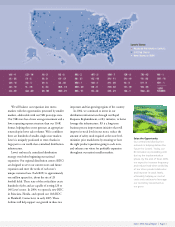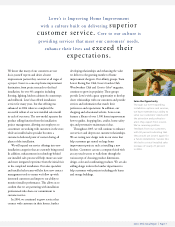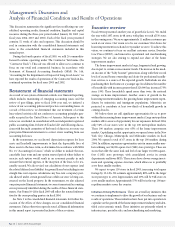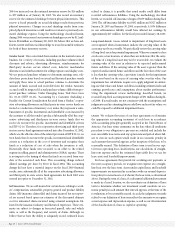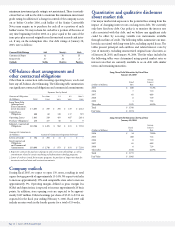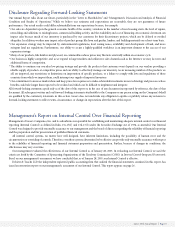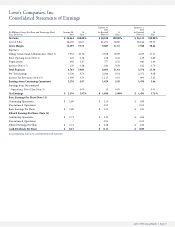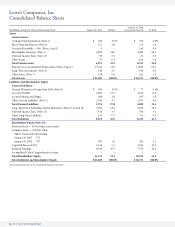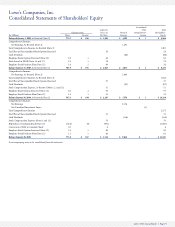Lowe's 2004 Annual Report Download - page 22
Download and view the complete annual report
Please find page 22 of the 2004 Lowe's annual report below. You can navigate through the pages in the report by either clicking on the pages listed below, or by using the keyword search tool below to find specific information within the annual report.
Page 20 Lowe’s 2004 Annual Report
2004 we increased our discontinued inventory reserve by $16 million
to $77 million as of January 28, 2005. We also record an inventory
reserve for the estimated shrinkage between physical inventories. This
reserve is based primarily on actual shrinkage results from previous
physical inventories. Changes in actual shrinkage results from com-
pleted physical inventories could result in revisions to previously esti-
mated shrinkage expense. Using the methodology described herein,
during 2004 we increased our inventory shrinkage reserve by $12 mil-
lion to $94 million as of January 28, 2005. We believe that we have suf-
ficient current and historical knowledge to record reasonable estimates
for both of these inventory reserves.
Vendor Funds We receive funds from vendors in the normal course of
business for a variety of reasons, including purchase-volume-related
discounts and rebates, advertising allowances, reimbursements for
third-party in-store service related costs, defective merchandise
allowances and reimbursements for selling expenses and display costs.
We use projected purchase volumes to determine earnings rates, vali-
date those projections based on actual and historical purchase trends
and apply those rates to actual purchase volumes to determine the
amount of funds accrued and receivable from the vendor. Amounts
accrued could be impacted if actual purchase volumes differ from pro-
jected purchase volumes. Under Emerging Issues Task Force Issue
No. 02-16 (EITF 02-16), “Accounting by a Customer (Including a
Reseller) for Certain Consideration Received from a Vendor,” cooper-
ative advertising allowances and third-party in-store service funds are
treated as a reduction of inventory cost, unless they represent a reim-
bursement of specific, incremental and identifiable costs incurred by
the customer to sell the vendor’s product. Substantially all of the coop-
erative advertising and third-party in-store service funds that we
receive do not meet the specific, incremental and identifiable criteria
in EITF 02-16. Therefore, for cooperative advertising and third-party
in-store service fund agreements entered into after December 31, 2002,
which was the effective date of the related provision of EITF 02-16, we
treat funds that do not meet the specific, incremental and identifiable
criteria as a reduction in the cost of inventory and recognize these
funds as a reduction of cost of sales when the inventory is sold.
Historically, these funds were recorded as an offset to the related
expense in selling, general and administrative (SG&A) expense. There
is no impact to the timing of when the funds are received from ven-
dors or the associated cash flows. This accounting change reduced
diluted earnings per share by $0.16 in fiscal 2004. This accounting
change did not have a material impact on the fiscal 2003 financial
results, since substantially all of the cooperative advertising allowance
and third-party in-store service fund agreements for fiscal 2003 were
entered into prior to December 31, 2002.
Self-Insurance We are self-insured for certain losses relating to work-
ers’ compensation, automobile, property, general and product liability
claims. Self-insurance claims filed and claims incurred but not report-
ed are accrued based upon our estimates of the discounted ultimate
cost for uninsured claims incurred using actuarial assumptions fol-
lowed in the insurance industry and historical experience. These esti-
mates are subject to changes in forecasted payroll, sales and vehicle
units, as well as the frequency and severity of claims. Although we
believe that we have the ability to adequately record estimated losses
related to claims, it is possible that actual results could differ from
recorded self-insurance liabilities. Using the methodology described
herein, we recorded self-insurance charges of $279 million during fiscal
2004. The self-insurance liability was $432 million and $327 million at
January 28, 2005 and January 30, 2004, respectively. A 10% difference
in our self-insurance liability would have affected net earnings by
approximately $27 million for the fiscal year ended January 28, 2005.
Long-Lived Assets Losses related to impairment of long-lived assets
are recognized when circumstances indicate the carrying values of the
assets may not be recoverable. We periodically review the carrying value
of long-lived assets for potential impairment. When we commit to close
or relocate a store location, or when there are indicators that the carry-
ing value of a long-lived asset may not be recoverable, we evaluate the
carrying value of the asset in relation to its expected undiscounted
future cash flows. If the carrying value of the asset is greater than the
expected undiscounted future cash flows and the fair value of the asset
is less than the carrying value, a provision is made for the impairment
of the asset based on the excess of carrying value over fair value. Our
impairment loss calculations require us to apply judgment in estimat-
ing asset fair values and future cash flows, including estimated sales and
earnings growth rates and assumptions about market performance.
Using the impairment review methodology described herein, we
recorded long-lived asset impairment charges of $31 million during fis-
cal 2004. If actual results are not consistent with the assumptions and
judgments used in estimating future cash flows and asset fair values, we
could be exposed to additional impairment losses.
Leases We evaluate the terms of our lease agreements to determine
the appropriate accounting treatment of each lease in accordance
with accounting principles generally accepted in the United States of
America. Our lease terms commence on the date when all conditions
precedent to our obligation to pay rent are satisfied and include the
non-cancelable lease terms and any option renewal period where fail-
ure to exercise such option would result in an economic penalty in
such amount that renewal appears, at the inception of the lease, to be
reasonably assured. This definition of lease term is used in our capi-
tal versus operating lease classifications, our calculations of straight-
line rent expense and in the estimated depreciable lives we use for
lease assets and leasehold improvements.
For lease agreements that provide for escalating rent payments or
free-rent occupancy periods, we recognize rent expense on a straight-
line basis over the lease term. Assets under capital leases and leasehold
improvements are amortized in accordance with our normal deprecia-
tion policy for owned assets or, if shorter, the lease term, as determined
above. During the term of a lease, if a substantial additional investment
is made in a leased location, we also reevaluate our definition of lease
term to determine whether our investment would constitute an eco-
nomic penalty in such amount that renewal appears, at the time of the
reevaluation, to be reasonably assured. As such, the judgments we make
related to our definition of lease term affect the amounts we recognize
as rent expense and depreciation expense, as well as our determination
of the classification of a lease as capital or operating.



